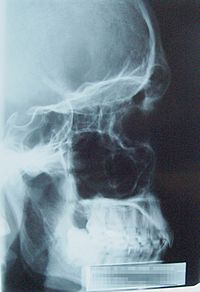Paranasal sinuses facts for kids

Sinuses sideways-on in an X-ray image
Paranasal sinuses are parts of the nasal cavity. They are usually counted to be part of the respiratory system. They are mucous membranes, which are mostly inside bones. These bones are then filled with air, which makes the skull look bigger, without adding much extra weight. Prenasal cavities can be found in mammals, most birds, dinosaurs, and crocodilians.
Since sinuses are in virtually all land vertebrates, they must have a function. They are covered with a mucosa, epidermal cells which are moist and make mucus. This moistens and warms the air on its way into the lungs. The mucus also picks up particles which come in with the air. A variety of possible functions have been proposed:
- Decreasing the relative weight of the front of the skull, and especially the bones of the face.
- Increasing resonance of the voice.
- Providing a buffer against face damage.
- Insulating sensitive structures like dental roots and eyes from rapid temperature fluctuations in the nasal cavity.
- Humidifying and heating of inhaled air because of slow air turnover in this region.
- Regulation of intranasal and serum gas pressures.
- Immunological defence.
Images for kids
See also
 In Spanish: Senos paranasales para niños
In Spanish: Senos paranasales para niños

All content from Kiddle encyclopedia articles (including the article images and facts) can be freely used under Attribution-ShareAlike license, unless stated otherwise. Cite this article:
Paranasal sinuses Facts for Kids. Kiddle Encyclopedia.
